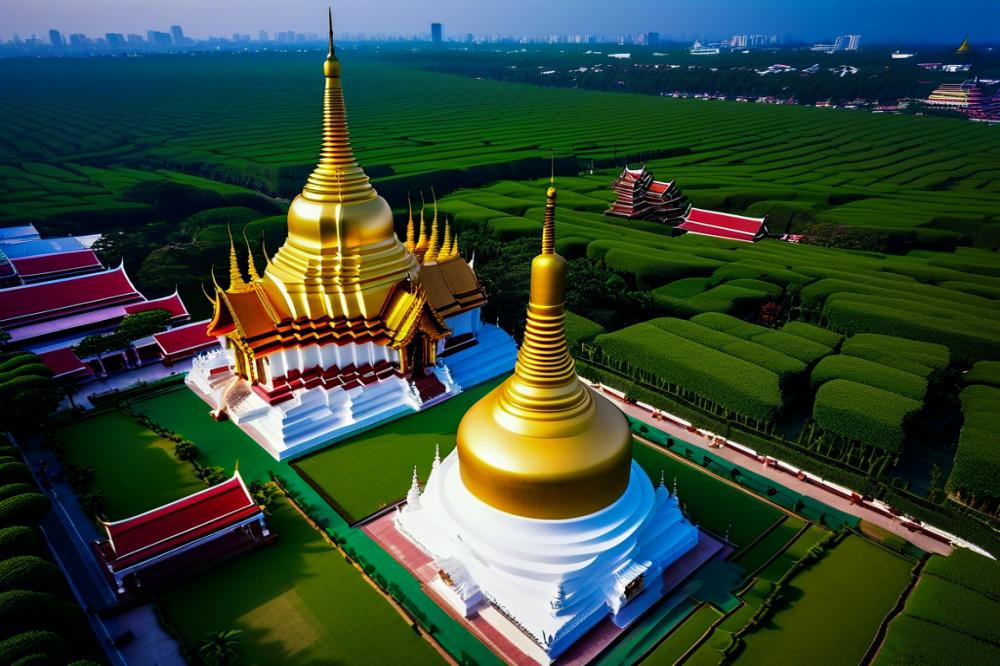Overview of Wat Phra That Hariphunchai and Its Significance
Located in the heart of Northern Thailand, Wat Phra That Hariphunchai stands as a testament to the region’s rich cultural heritage. This historic temple dates back to the 10th century, showcasing impressive Buddhist architecture that draws visitors from around the world. The temple is not only a place of worship; it also serves as a pilgrimage site for many, holding deep religious significance for Buddhists. Its centerpiece, a magnificent stupa, represents the spiritual aspirations of the local community.
Importance in Thailand adventure holidays

For travelers seeking adventure, this temple offers a unique opportunity to explore ancient history while experiencing local traditions. Many consider visiting this site a highlight of their trip to Thailand. The serene atmosphere provides a perfect escape from the hustle of daily life. Adventurers are often captivated by the stories that surround the temple and the vibrant culture of Lamphun.
Brief Mention of Its Location in Lamphun

Lamphun, a charming town, is home to Wat Phra That Hariphunchai. Nestled among lush scenery, it enhances the allure of this famous temple. The location is easy to reach, making it a popular stop for those exploring Northern Thailand. Whether one is drawn by the architecture, the history, or the spiritual energy, the temple’s significance resonates with all who visit.
Historical Context

Background of Hariphunchai Kingdom
The Hariphunchai Kingdom was one of the earliest civilizations in northern Thailand. Established around the 10th century, it played a significant role in the region’s development. This kingdom was known for its rich culture and strong ties to Buddhism. The influence of the Hariphunchai people can still be felt today, especially through their customs and beliefs. They contributed greatly to the spread of Buddhist practices in this part of the country.
The Ancient History of Wat Phra That Hariphunchai
Built during the height of the Hariphunchai Kingdom, the historic temple is a testament to ancient architecture. Constructed in the 12th century, it features a stunning stupa that showcases remarkable craftsmanship. This building became an essential religious center for locals and travelers alike. Over the centuries, it was a popular pilgrimage site for those seeking spiritual growth. Its enduring presence speaks volumes about the community’s dedication to its religious heritage.
Key Historical Figures Associated with the Temple
Several notable figures are linked to the temple’s rich history. King Ekkathat was among the most prominent, often credited for expanding its significance. Local legends say his support helped elevate the site as a center for Buddhist learning. Other monks and scholars contributed ideas that shaped the temple’s practices and rituals. Their efforts ensured that Wat Phra That Hariphunchai remained a vital part of local traditions.
Evolution of the Temple Over Centuries
Throughout its long history, the temple has undergone numerous renovations and restorations. Early influences can still be seen in its traditional architecture. Changes made during the Lanna Kingdom period brought new styles and elements. These adaptations symbolize the blend of local customs with broader Buddhist architecture. Today, the temple continues to serve as a focal point for cultural heritage, drawing visitors for both worship and exploration.
Architectural Features

The Wat Phra That Hariphunchai is a splendid example of Buddhist architecture in northern Thailand. Built in the 11th century, this historic temple reflects deep cultural heritage and ancient history. Visitors often admire the intricate design that tells stories of local traditions. The architecture showcases a blend of artistry and devotion, inviting many to explore its beauty.
Notable Elements
One of the most striking features of the temple is its stupa. This towering structure, adorned with intricate carvings, represents the heavens. Devotees often circle the stupa as part of their daily rituals, emphasizing its role in religion. Gold leaf covers the stupa, making it shimmer brightly in the sunlight. This attention to detail draws countless pilgrims to this sacred site.
Influence of Northern Thailand Architecture
Northern Thailand’s architectural style heavily influenced the design of Wat Phra That Hariphunchai. Characteristics such as tiered roofs and floral motifs are common in temples from this region. These features create a sense of harmony with the natural surroundings. Influences from Lanna culture can be seen in the structure’s layout and decorative elements. Local artisans poured their skills into crafting this temple, reflecting a deep connection to their heritage.
Symbolism Within the Architectural Features
Symbolism permeates every aspect of the temple’s design. The stupa symbolizes the Buddha’s teachings, which guide followers through their spiritual journeys. In many ways, the temple itself serves as a pilgrimage site for those seeking enlightenment. Many artwork pieces display figures from Buddhist lore, inspiring contemplation. Every pillar and carving invites visitors to ponder the meaning behind the design, deepening their appreciation for this sacred space.
Cultural and Religious Significance
Role of Wat Phra That Hariphunchai as a Pilgrimage Site
Wat Phra That Hariphunchai is a major pilgrimage site for Buddhists. Many people travel from distant places to pay their respects. The stupa at the temple holds great importance in Buddhist beliefs. It is said to house relics of the Buddha, making it a sacred destination. Visitors often participate in rituals and offerings, deepening their spiritual connections. The temple serves as a focal point for those seeking enlightenment.
Cultural Heritage and Local Traditions Associated with the Temple
The historic temple reflects rich cultural heritage in northern Thailand. Local traditions have been passed down through generations. Many artisans craft intricate decorations to honor the temple’s significance. Special ceremonies often culminate in elaborate processions. Residents take pride in their customs, celebrating their history through these practices. Each event showcases the town’s deep connections to Buddhism and respect for ancient history.
Festivals and Rituals Held at the Temple
Throughout the year, various festivals take place at the temple. The Wat Phra That Hariphunchai was a site for the famous ‘Loy Krathong’ festival. People gather to launch floating baskets on water, symbolizing the release of negativity. Other rituals include merit-making ceremonies, where offerings are given to monks. These events draw many participants, enhancing communal bonds and shared spirituality. Each observance reinforces the cultural identity of the local community.
Impact of Buddhism on the Local Community
Buddhism has a profound impact on the lives of those in Lamphun. The teachings of Buddha influence daily activities and moral values. Many schools incorporate Buddhist principles into their curricula. Local artisans often create works inspired by religious themes. Community service projects also stem from Buddhist compassion, demonstrating altruism in action. The presence of this historic temple continues to shape societal norms and values in the region.
Visiting Wat Phra That Hariphunchai
Practical information for travelers
Wat Phra That Hariphunchai is a historic temple located in Lamphun, Thailand. It attracts many visitors each year. The best times to visit are in the early morning or late afternoon. This allows you to avoid the midday heat and enjoy quieter surroundings. Remember to dress appropriately. Visitors should wear respectful clothing that covers shoulders and knees as a sign of respect for the Buddhist culture.
Entrance fees are not typically charged, making it accessible for everyone. Guided tours are available for those who wish to learn about the temple’s ancient history and its significance. Free maps can be found at the entrance to help navigate the area.
Tips for exploring the temple and surroundings
When exploring, take your time to appreciate the intricate details of the Buddhist architecture. Pay attention to the beautiful stupa; it’s a key highlight of the temple. Local traditions are an essential part of the experience, so consider observing any ceremonies. Speaking quietly is important. It shows respect for those practicing their religion.
Photography is allowed, but keep in mind that some areas might restrict it. Ask for permission before taking pictures of people. Additionally, stay hydrated, especially during hot months. Refreshments can be bought from nearby vendors.
Nearby attractions to complement the visit
After visiting the temple, consider exploring nearby attractions. The Hariphunchai National Museum showcases artifacts related to the region’s cultural heritage. A short walk can lead you to local markets where traditional crafts and food await.
Another interesting site is the ancient city wall of Lamphun. It provides a glimpse into the past and enhances your understanding of the area’s history. Be sure not to miss the local eateries. Trying traditional northern Thai dishes is a delightful experience.
Transport and accessibility options
Getting to Lamphun can be done by bus or train from Chiang Mai. Public transport is frequent, making it easy for travelers. Once there, tuk-tuks or taxis are available for local travel. Renting a bicycle is also a popular choice for those who enjoy riding.
The temple is accessible for most visitors, with flat paths and ramps. However, some areas may have stairs. If mobility is a concern, plan your visit accordingly. Accessibility needs vary, so it’s best to check in advance.
Final Reflections on Wat Phra That Hariphunchai
This historic temple holds immense significance not only for the local community but also for visitors from around the world. It represents a rich cultural heritage that has been preserved over centuries. Pilgrims and tourists alike are drawn to its ancient architecture, stunning golden stupa, and calming atmosphere. Each visit offers a glimpse into the artistic craftsmanship and religious devotion of the past.
For anyone planning a trip to Thailand, this temple should definitely be included in their adventure itinerary. Visiting Wat Phra That Hariphunchai is more than just a sightseeing opportunity; it is a chance to immerse oneself in the culture and history of the region. Engaging with this landmark allows travelers to connect deeply with the traditions that shape modern Lamphun.
Efforts to preserve cultural landmarks like this temple are crucial. They help maintain the stories and experiences that define a community. Promoting tourism should happen alongside a commitment to protecting these historical sites. Ultimately, responsible travel can contribute to sustaining places that hold great historical value, ensuring future generations can appreciate them too.



